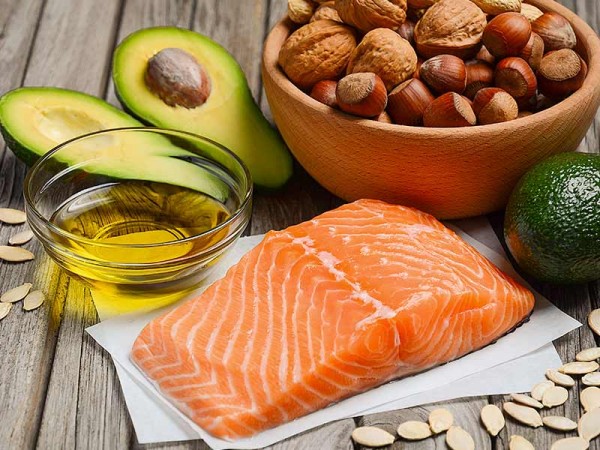What do a crispy fried trout, a spicy linseed bread and cereal with hemp seeds have in common? They are all rich in good Omega 3 fatty acids. The polyunsaturated fatty acids are essential for life and make an important contribution to a healthy diet: they contribute to normal cholesterol levels and support normal brain, heart and vision function.
But our body cannot produce the healthy fats itself. Therefore, we have to absorb them through food: Algae, fish and sea animals, as well as some plants and seeds, contain large amounts of Omega 3 fatty acids.
Omega 3 fatty acids and the human body
Omega 3 are polyunsaturated fatty acids. In contrast to saturated fatty acids, they combine easily with other substances and are well absorbed by the body. They maintain many essential body functions.
A total of 11 different fatty acids belong to the omega-3 fatty acids. Three of them are particularly relevant for the human organism: EPA (eicosapentaenoic acid), DHA (docosahexaenoic acid) and ALA (alpha-linolenic acid).
How much Omega 3 should we take in daily?
The European Food Safety Authority (EFSA) and the German Nutrition Society (DGE) recommend a daily intake of 250 mg EPA or DHA.
Which foods contain Omega 3?
Many valuable Omega 3 fatty acids are slumbering in the sea. Algae are true Omega 3 wonders. As many fish feed on them, they also absorb the Omega 3 fatty acids EPA (eicosapentaenoic acid) and DHA (docosahexaenoic acid). However, you can also synthesize them yourself.
Fatty fish are rich in Omega 3:
- Salmon
- Tuna
- Mackerel
- Herring
- Anchovy
- Sardine
- Trout
 Highly concentrated fish oil is also available in perfect doses in our fish oil capsules. The valuable green-lipped mussel, cultivated in aquaculture, is also rich in Omega 3 and many important trace elements, minerals and vitamins: Green-lipped Mussel Capsules
Highly concentrated fish oil is also available in perfect doses in our fish oil capsules. The valuable green-lipped mussel, cultivated in aquaculture, is also rich in Omega 3 and many important trace elements, minerals and vitamins: Green-lipped Mussel Capsules
Vegetable oils contain Omega 3: (Omega 3 fatty acid content in %)
- Linseed oil: 56 - 71 %
- Chia oil: up to 64 %
- Walnut oil: approx. 13 %
- Rapeseed oil: approx. 9 %
Vegan food with Omega 3:
- Chia seeds (very rich in Omega 3)
- Linseed (very rich in Omega 3)
- Walnuts
- Avocados
- Hemp seeds
- Seeds and nuts
Good to know: Omega 3 and Omega 6 fatty acids compete with each other
How much Omega 3 we ultimately consume also depends on how much Omega 6 fatty acids we consume. What many people do not know: Many foods also contain the (rather unknown) Omega 6 fats. They also support numerous bodily functions, but our body needs much less Omega 6 than Omega 3 fatty acids.
When we eat, the ratio of Omega 3 to Omega 6 fatty acids is crucial. The two polyunsaturated fatty acids compete for the same enzymes. An excess of Omega 6 can therefore have a negative effect on our body. The German Society for Nutrition (DGE) recommends a ratio of 5:1 between Omega 6 and Omega 3 fatty acids.
Omega 6 fatty acids are found in all vegetable oils and animal products. Significant amounts of Omega 3 fatty acids are found in a few vegetable foods such as walnuts, millet and chia seeds, as well as in fatty fish and seafood.
If we take in too little Omega 3
Before they were clearly identified as fatty acids, scientists called Omega 3 fatty acids vitamin F. This also shows how important they are for humans.
An Omega 3 deficiency is not so easy to diagnose. The symptoms are very different and sometimes unspecific:
- Muscle weakness
- Inner restlessness
- Visual impairment
- Skin problems
- Tiredness
Especially for vegans, vegetarians or people who don't like to eat fish, it can sometimes be difficult to get enough healthy fatty acids every day. Here it is important to regularly include very Omega-3-rich vegan foods such as millet, chia or walnuts in the diet. Omega 3 capsules such as green-lipped mussel capsules or high-dose fish oil capsules also help to cover the daily Omega 3 requirement. The Omega 3 fish oil capsules from Vitamaze have an ideal ratio of 40% EPA (eicosapentaenoic acid) and 30% DHA (docosahexaenoic acid) per capsule.
This might also be of interest to you
-
Recipe ideas: 4 recipes for your healthy breakfast
Start the day perfectly - with a healthy, balanced breakfast. This can be achieved with a delicious muesli, for example, which provides important vitamins and minerals. -
Tips for a successful change of diet
Do you ask yourself how you can manage to eat healthier food in the long term? We have summarised everything about the pantry, shopping list & finished products for you. -
7 tips against joint problems
Our joints perform hard work for a lifetime. If you want to prevent joint problems, the best way is to exercise and our other useful tips.
Pictures: istockphoto | JulijaDmitrijeva, istockphoto | uhhha











